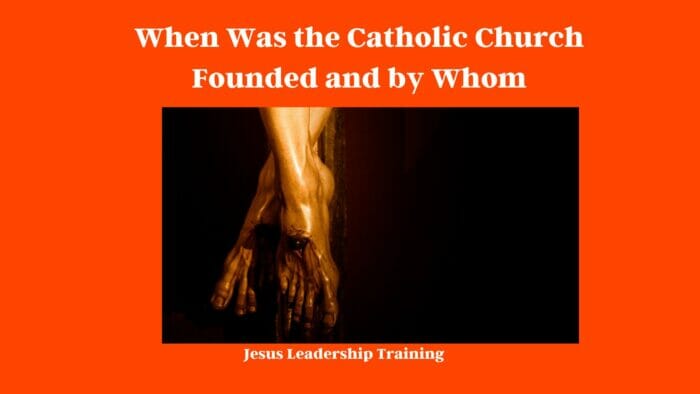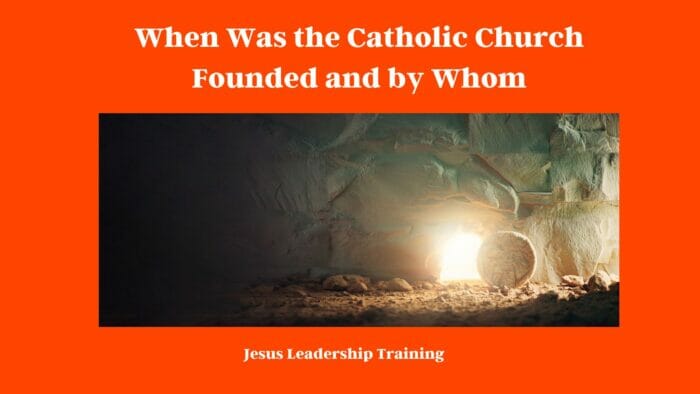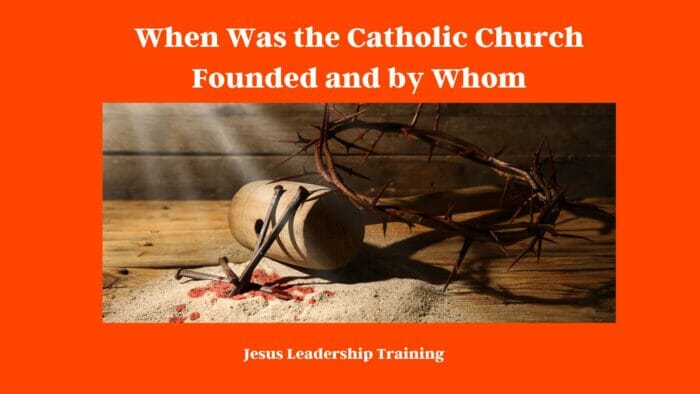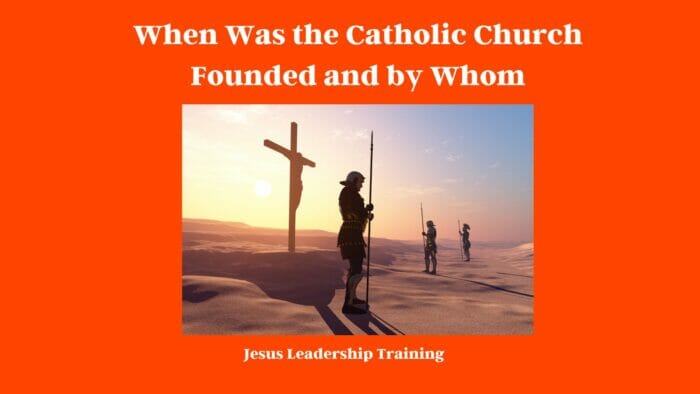When Was the Catholic Church Founded and by Whom? The Catholic Church, one of the oldest and most influential religious institutions in the world, traces its origins back to the time of Jesus Christ and the establishment of the early Christian community. Understanding the founding of the Catholic Church requires delving into the rich history of Christianity and its development over the centuries. Let’s explore the journey of how and when the Catholic Church was founded.
Table of Contents
When Was the Catholic Church Founded and by Whom?
The Catholic Church, also known as the Roman Catholic Church, is a Christian denomination with over a billion followers worldwide. It is led by the Pope, who serves as the spiritual head of the Church. The founding of the Catholic Church holds immense significance as it marks the establishment of a religious institution that has played a pivotal role in shaping Western civilization and influencing countless lives throughout history.
The founding of the Catholic Church isn’t associated with a specific date, rather, it’s a historical process that took place over centuries. However, some key dates and periods can be pointed out in the development and establishment of the Catholic Church:
| Date/Period | Event/Development |
|---|---|
| 33 AD | Traditional date of the Resurrection of Jesus Christ and the beginning of his Great Commission for his apostles to spread his teachings, marking the start of Christian religious practice. |
| 64 AD | The first major persecution of Christians under the Roman Emperor Nero. |
| 313 AD | The Edict of Milan issued by Emperor Constantine, ending the persecution of Christians and making Christianity a tolerated religion in the Roman Empire. |
| 380 AD | The Edict of Thessalonica made Christianity the state religion of the Roman Empire. Catholicism, as we understand it today, began to take a more defined shape. |
| 431 AD | The Council of Ephesus, the third ecumenical council that recognized Mary as Theotokos or “God-bearer”, a central doctrine of Catholic faith. |
| 451 AD | The Council of Chalcedon affirms the dual nature of Christ (divine and human), another key doctrine in Catholicism. |
| 1054 AD | The Great Schism occurs, formally separating the Eastern and Western Christian Churches. The Bishop of Rome, known as the Pope, becomes the clear leader of the Western Church, now known as the Roman Catholic Church. |
| 1962-1965 AD | The Second Vatican Council, an important council in modern times, modernized many Catholic practices. |

Remember, these dates are representative of significant events in the formation and development of the Catholic Church and not strictly a ‘founding’ timeline.
Early Origins of Christianity
To understand the founding of the Catholic Church, we must first look at the origins of Christianity itself. Christianity emerged in the 1st century AD, following the life and teachings of Jesus Christ. Jesus, considered the Son of God by Christians, preached love, compassion, and the Kingdom of God. His teachings attracted a group of followers known as the Apostles.
Peter as the Rock
Among the Apostles, Peter holds a special place in Christian tradition. According to the New Testament, Jesus proclaimed Peter as the “rock” upon which He would build His Church. This declaration is significant as it establishes Peter’s role as the foundation of the Church. The Catholic Church recognizes Peter as the first Pope and believes in the apostolic succession, whereby subsequent Popes are considered successors of Peter.
The following table provides an overview of the main events in the life of the Apostle Peter, one of the most prominent figures in the New Testament:

| Event | Description |
|---|---|
| Called to Follow Jesus | Peter, originally named Simon, was a fisherman by trade. He was called to be a disciple by Jesus while he was fishing on the Sea of Galilee. |
| Name Change | Jesus gave Simon a new name, Peter, which means “rock.” This foreshadowed Peter’s future role as a foundational leader in the early Church. |
| Walking on Water | In a demonstration of both faith and doubt, Peter walked on water towards Jesus but began to sink when he lost faith. |
| Confession of Faith | Peter confessed that Jesus was the Christ, the Son of God, a pivotal moment for him and for the other disciples. |
| Transfiguration | Peter was one of the three apostles who witnessed the Transfiguration of Jesus on the mountaintop. |
| Denial of Jesus | Despite his deep loyalty to Jesus, Peter denied knowing him three times after Jesus was arrested, fulfilling a prediction Jesus had made. |
| Post-Resurrection Appearance | After His resurrection, Jesus appeared to Peter and the other disciples and asked Peter three times if he loved Him, and each time Peter affirmed that he did. Jesus then commissioned Peter to “feed His sheep,” signifying Peter’s leadership role. |
| Pentecost | Peter was present at the event of Pentecost, where the Holy Spirit descended upon the apostles. He delivered a powerful sermon that resulted in about 3,000 people becoming followers of Jesus. |
| Leadership in the Early Church | Peter assumed a leadership role in the early Christian Church in Jerusalem, making decisive arguments at the Council of Jerusalem about the gentile converts to Christianity. |
| Martyrdom | According to early Church tradition, Peter was crucified upside down in Rome under Emperor Nero’s persecution. His burial place is believed to be where St. Peter’s Basilica stands today. |
These key events from Peter’s life underline his transformation from a simple fisherman to the leader of the early Christian Church and highlight his important role in the spread of Christianity.

The first three centuries of the Catholic Church were marked by numerous important leaders. However, due to historical record limitations, the most documented leaders during this period were the Bishops of Rome, also known as the Popes. Here’s a table listing the key leaders (Popes) of the Catholic Church during the first three centuries:
| Years in Office | Pope | Significant Contributions |
|---|---|---|
| c. 32 – c. 64 | St. Peter | Regarded as the first Pope, he established the church in Rome with Paul, served as bishop, and was martyred under Nero. |
| c. 64 – c. 76 | St. Linus | The immediate successor to Peter, affirmed the teachings of the Apostles and continued the administration of the Church in Rome. |
| c. 76 – c. 88 | St. Anacletus (Cletus) | Organized the ecclesiastical form of the Church’s hierarchy and ordained an unspecified number of priests. |
| c. 88 – c. 99 | St. Clement I | His letter to the Corinthians, known as 1 Clement, speaks to the structure and hierarchy of the Church. |
| c. 100 – c. 109 | St. Alexander I | Introduced the use of holy water in purification rites and established the tradition of blessing houses with salt and water. |
| c. 140 – c. 155 | St. Pius I | The Church grew significantly under his pontificate. He is also traditionally associated with the establishment of the Easter date. |
| c. 189 – c. 199 | St. Victor I | He changed the language of the Church from Greek to Latin and established the date of Easter. |
| c. 199 – c. 217 | St. Zephyrinus | During his pontificate, the Church faced the issue of modalism, a heresy denying the Trinity. |
| c. 218 – c. 222 | St. Callixtus I | Known for his “Christian mercy”, where he integrated repentant sinners back into communion, causing some controversy. |
| c. 283 – c. 296 | St. Caius | His pontificate was during a period of relative peace for the Church, allowing him to decree that before a man could be chosen as bishop, he must first be porter, lector, exorcist, acolyte, subdeacon, deacon, and priest. |
| c. 296 – c. 304 | St. Marcellinus | His pontificate ended with the beginning of Diocletian’s persecutions, which were particularly severe. |
Please note, the early Church history is not as well-documented as later periods, and exact dates, contributions, and even the order of these leaders may be the subject of scholarly debate.
Foundation of the Catholic Church
The formal recognition of the Catholic Church as an institution can be traced back to the Council of Nicaea in 325 AD. This council, convened by Emperor Constantine the Great, brought together bishops from various Christian communities to address theological disputes and establish doctrinal unity. The Council of Nicaea affirmed the divinity of Jesus and solidified the foundation of the Catholic Church.
Early Developments and Challenges
In the centuries that followed, the Catholic Church experienced both growth and challenges. Early Christian communities spread throughout the Roman Empire, despite facing persecution from various emperors who viewed Christianity as a threat. The Church’s resilience in the face of adversity contributed to its growth and solidified its place as a prominent religious institution.
Influence of Constantine the Great
The reign of Emperor Constantine the Great proved to be a turning point in the history of the Catholic Church. Constantine issued the Edict of Milan in 313 AD, which granted religious tolerance to Christians and ended the persecution they faced. This newfound freedom allowed Christianity to flourish, and Constantine himself became a patron of the Church.
Constantine’s influence extended to the theological realm as well. In 381 AD, the Council of Constantinople revised the Nicene Creed, a statement of faith that laid the foundation for Christian doctrine. This council further solidified the influence of the Catholic Church and its role in shaping the beliefs of Christians.
Establishment of the Papacy
The development of the Papacy, the office of the Pope, played a significant role in the formation of the Catholic Church. Over time, the Bishop of Rome, who was considered the successor of Peter, gained prominence and authority. The Pope became the central figure of the Church, providing guidance, leadership, and a unifying force for Catholics worldwide.
The establishment of the papacy in the Catholic Church was a gradual process that involved several significant events and milestones. Here is a table of some key events and their descriptions:
| Year/Period | Event | Description |
|---|---|---|
| 33 AD | The Ministry of Peter | Peter, considered the first Pope, began his ministry after Jesus’ death and resurrection. He established the church in Rome, which laid the foundation for the papacy. |
| 64-67 AD | Martyrdom of Peter | Peter was martyred under the rule of Emperor Nero. His death emphasized the authority of the Bishop of Rome, as Peter was considered the first among the apostles. |
| 88-99 AD | Epistle of Clement I | Pope Clement I’s letter to the Corinthians reaffirmed the hierarchical authority in the Church, with the Bishop of Rome at the top, thereby establishing a clear precedent for the papacy. |
| 107 AD | Ignatius of Antioch’s Letter | Ignatius wrote a letter to the Smyrnaeans in which he affirmed the supremacy of the Church of Rome over other Christian communities, further solidifying the role of the Bishop of Rome as the Pope. |
| 250 AD | Decius’ Persecution | The Pope became a central figure of unity during the persecution under Emperor Decius. Pope Fabian was one of the victims, and the courage of such martyred Popes during the persecutions added to the growing recognition and respect of the papacy. |
| 313 AD | Edict of Milan | Emperor Constantine legalized Christianity, which eventually led to an increased influence and authority of the Pope in both religious and secular matters. |
| 380 AD | Edict of Thessalonica | Emperor Theodosius declared Christianity as the state religion of the Roman Empire, further enhancing the status and authority of the Pope. |
| 445 AD | Valentinian III’s Decree | The Roman Emperor Valentinian III recognized the Pope’s primacy over all the churches, legally formalizing the Pope’s position as the religious leader of the Western Church. |
Please note that the dates are approximations as exact records for some events may not exist. Also, this table summarizes complex historical events and trends which involved various social, political, and theological factors.
Split between Eastern Orthodox and Roman Catholic
In the 11th century, a major split occurred between the Eastern Orthodox Church and the Roman Catholic Church. This event, known as the East-West Schism of 1054, led to the division of Christianity into two distinct branches. The schism was the result of differences in theological beliefs, practices, and disputes over authority. While the Eastern Orthodox Church developed in the Byzantine Empire, the Catholic Church continued to grow in the West.
The Catholic Church has a rich and complex history that has been developing for centuries. Its origin can be traced back to the first century AD, and it has many layers of development, including the early Christian Church, the Roman Empire, and the papacy of Pope Gregory I. The Catholic Church is the world’s oldest and largest Christian denomination, and its teachings and practices have influenced generations of believers.
The Origin of Papal Supremacy in the Catholic Church
The Catholic Church’s origin was in the early church, which was a small group of believers that followed the teachings of Jesus Christ. The early Church was mostly decentralized and led by local bishops. As the Church grew in size and influence, it began to be more organized, and the papacy was established as the spiritual leader of the Church. It was during this period that the idea of papal supremacy began to take shape, and the papacy was given supreme authority over all matters of faith and doctrine.
Tracing the Start of the Catholic Church
The Catholic Church can be traced back to the first century AD, when Jesus Christ began his ministry. Jesus’ teachings and example were passed on by his disciples, and the early Church began to form. The early Church was led by local bishops who were in charge of teaching and communicating the faith to their local congregations. The Church slowly expanded, and by the fourth century AD, it had become the dominant faith in the Roman Empire.
Early Christian Beliefs and Practices
The early Christians believed in the teachings of Jesus Christ and sought to live according to his commands. They believed in one God, the Trinity, and the teachings of the Old and New Testaments. They also practiced baptism, communion, and the Eucharist, and they had a strong sense of community and charity.
The Early Catholic Church, like today’s Catholic Church, held a number of key beliefs that were fundamental to their faith. The following table presents some of the most basic beliefs of the Early Catholic Church:
| Belief | Description |
|---|---|
| Trinity | This foundational Christian belief holds that God exists as three persons – Father, Son, and Holy Spirit – in one divine essence. |
| Incarnation | The belief in Jesus Christ as the Son of God who became flesh (human) for the salvation of mankind. |
| Resurrection | The belief that Jesus Christ was crucified, died, and rose from the dead on the third day, opening the way to eternal life for those who believe in him. |
| Sacraments | Seven sacred rites were instituted by Christ to confer grace, including Baptism, Eucharist, Confirmation, Reconciliation, Anointing of the Sick, Marriage, and Holy Orders. |
| Apostolic Succession | The belief that the authority given to the Apostles by Jesus Christ has been passed down through the bishops of the Church, thereby maintaining a direct link to Christ and his teachings. |
| Primacy of the Pope | The Bishop of Rome, or the Pope, was believed to hold the highest authority in the Church on Earth, being the successor of Saint Peter. |
| Scripture and Tradition | Both the Holy Scriptures and the Tradition of the Church were considered important sources of divine revelation. |
| Original Sin | The belief that humanity inherited a state of sin from the first humans, Adam and Eve, and that baptism is necessary for salvation and removal of this sin. |
| Communion of Saints | The belief in a spiritual solidarity between the faithful on Earth, the souls in Purgatory, and the blessed in Heaven. |
| Last Things | Beliefs concerning death, judgement, heaven, hell, and the second coming of Jesus Christ. |
These beliefs have evolved and have been clarified over the centuries, but their core tenets remain at the heart of Catholic doctrine.
The Roman Influence on Catholic Church Formation
The Roman Empire had a significant impact on the development of the Catholic Church. The Roman Emperor Constantine made Christianity the official religion of the empire in the fourth century AD, and this helped to spread the faith across the Roman world. In addition, the Roman Empire provided a structured system of governance for the Church, which helped to solidify its authority.
Pope Gregory I and the Catholic Church
Pope Gregory I was the first Pope to be officially recognized as the head of the Catholic Church. He was a reformer who worked to strengthen the Church’s doctrine and organization. He was responsible for the development of the papacy into a powerful spiritual leader, and he established the Catholic Church as the predominant Christian denomination.
Living a Catholic Faithful Life
Living a Catholic life is about more than just attending church services. It is about living a life of faithfulness and obedience to the teachings of the Church and to the teachings of Jesus Christ. This includes following the Ten Commandments, loving thy neighbor, and participating in the sacraments of the Church.
Bringing Catholic Teachings into the Home
In addition to attending Mass and participating in the sacraments, it is important for Catholics to bring the teachings of the Church into the home. This includes teaching children about the faith, praying together as a family, and reading the Bible together. This helps to ensure that the faith is passed down from generation to generation.
Early Christians and the Catholic Church
The early Christians were the first followers of Jesus Christ and the first members of the Catholic Church. They practiced a simple and humble faith, and they spread the teachings of Jesus to the world. The early Christians were persecuted and martyred for their faith, but their courage and dedication to the faith laid the foundation for the Church today.
Uncovering the Early Church’s History
The early Church’s history is not always easy to uncover, but there are several sources that can be used to learn about the early Church and its beliefs and practices. These sources include the New Testament, the writings of Church Fathers, and the writings of early Christian martyrs.
Establishing the Roman Catholic Church
The Roman Catholic Church was established in the fourth century AD when the Roman Emperor Constantine declared Christianity the official religion of the empire. This helped to spread the faith across the Roman world, and it also established the papacy as the spiritual leader of the Church.
The Catholic Church and the Development of Papal Supremacy
The Catholic Church was founded on the belief in the papacy, or the spiritual leadership of the Bishop of Rome. This was a departure from the earlier decentralized model of the Church, and it gave the papacy ultimate authority over the Church’s doctrine and practices. The papacy has been a powerful force in the Church ever since, and it is a key part of the Church’s identity and structure.
Exploring the Catholic Church’s Beginnings and Its Founders
The Catholic Church has a long and rich history that spans centuries. It is a complex and multifaceted organization, and it has been shaped by many different people and events. From the early Christians to Pope Gregory I, there are many founders and influences that have helped to shape the Church into what it is today.
The Catholic Church is a vast and complex institution with a long and rich history. Its origin can be traced to the early Church in the first century AD, and it has since been shaped by the Roman Empire, the papacy, and the teachings of Jesus Christ. The Catholic Church is the world’s oldest and largest Christian denomination, and its teachings and practices have been a source of inspiration and guidance for generations of believers.
Final Thoughts – When Was the Catholic Church Founded and by Whom?
The founding of the Catholic Church can be traced back to the time of Jesus Christ and the establishment of the early Christian community. It was through the recognition of Peter as the rock and the subsequent Council of Nicaea that the Catholic Church gained formal recognition and solidified its position as an influential religious institution. Over the centuries, the Catholic Church faced challenges, experienced growth, and played a crucial role in shaping the history of Christianity and the world.
FAQs
- When did the Catholic Church become an organized institution? The Catholic Church began to take shape as an organized institution in the 4th century AD, particularly with the Council of Nicaea in 325 AD.
- Who was the first Pope of the Catholic Church? According to Catholic tradition, Peter was the first Pope and is considered the foundation upon which the Church was built.
- What was the significance of the Council of Nicaea? The Council of Nicaea played a crucial role in establishing doctrinal unity within the early Christian community and affirming the divinity of Jesus Christ.
- Why did the Catholic Church split from the Eastern Orthodox Church? The East-West Schism of 1054 resulted from theological and cultural differences between the Eastern Orthodox and Roman Catholic Churches, leading to a formal split.
- How has the Catholic Church influenced history? The Catholic Church has had a profound impact on history, influencing art, literature, philosophy, politics, and shaping Western civilization as a whole.




